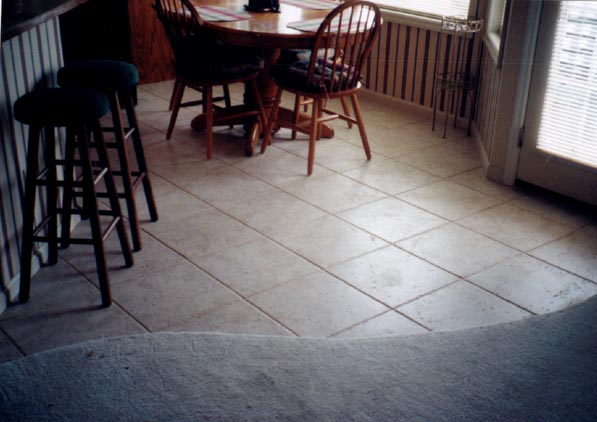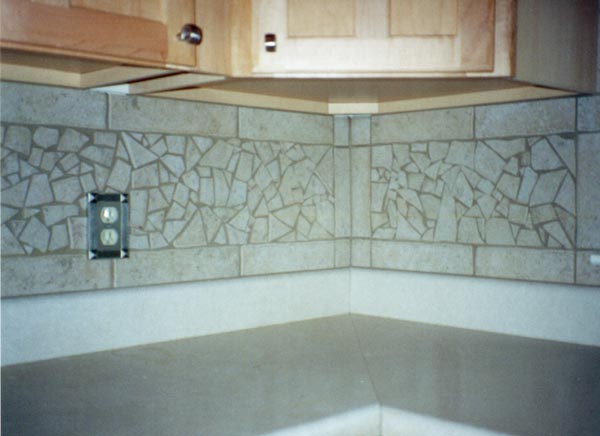...particular attention should be paid to waterproofing outdoor installations; either by using a waterproof
membrane underneath the tile and/or some type of below slab drainage. Quite popular are the waterproof membranes and a mud
bed to ensure the pitch is correct to prevent standing water...
...do be aware of the look that you expect from the finished project. What we're talking about here is the
shading of tiles...
...be careful when selecting tiles for your kitchen counters. A popular choice here are the high gloss wall
tiles which can be easily scratched...
...it's okay to use a floor tile on the wall or counters; but, do not use a wall tile on the floor. If you
decide to use a floor tile on a wall or counter; you will need to find out if a bullnose is available in that tile or figure
out what other options are available to finish the edge where needed...
...caulk anyplace where tile meets a wood/aluminum threshold in a doorway; where tile meets the tub; in
the corners where the walls meet in a tub/shower area; where tile walls and floors meet; where a backsplash meets the
counter, etc. Usually, the wood/aluminum flexs at a different rate than the tile and the grout will crack out...
...after pulling up old vinyl, etc,; the 'best' thing to do is to remove the old glue; either by using a
liquid adhesive remover or by some type of mechanical means. Remember to follow the directions with liquid adhesive removers
because if all of the old remover was not cleaned off, it could 'cause' a problem with the new adhesive bonding...
...clean, dry concrete is an excellent surface to lay tile to. On concrete, you'll be looking for cracks,
paint, sealed surfaces, etc. Concrete with cracks should have some type of crack suppression installed. If the concrete has
cracked; it has moved once; who's to say that it won't move again. Better to be safe than sorry. Paint should be removed.
Large dips in the concrete surface should be filled flat with the rest of the surface. You do not need a 'backerboard' on
concrete. If your installer says so, send him walking...
...on wood subfloors, if you have particleboard, it should be removed and replaced with a bc plywood. I'm
not a fan of osb (oriented strand board) either. I would recommend removing it also and replacing it with a bc plywood. The
verdict is actually still out on osb. If it gets wet and stays wet long enough, it will swell and that spells trouble...
...on wood subfloors, your subfloor should be approximately 1-1/4" glued and screwed before the installation
of tile. One example would a 3/4" bc plywood with a 1/2" backerboard bonded chemically and mechanically to it. Always use
a multi-purpose thinset mortar when working with wood subfloors...
...this is actually quite important; but, it seems that this isn't thought of 'till after the fact; but,
please think about faucets or electrical switches or anything like that and have it taken care of before the tile guy gets
there. I've had customers call the electrical guy to install switches after I've tiled all the bathroom walls from floor to
ceiling. It's kinda tough then. Or the time they decided they wanted new shower valves installed after all new tile walls
were put up. It's not gonna happen without ripping out and re-doing which usually includes a hefty little charge also...
...i believe that's it's also a good idea to grout the bottom of the toilet area where it meets the tile
floor. It looks nice, it will keep the toilet from rocking, and if it leaks in that critical area, you will know 'cause we
all know that grout is darker when it is wet...
...the wax-free toilet bowl gasket are really nice to use if you did not have to install any flange risers.
The toilet flange should be approximately flush with the top of the finished tile floor...
...when considering the installation of glass tiles; be sure to use a high quality white multipurpose thinset
mortar. Also, it is a good idea to back butter the tile completely as well as notch the substrate; this will help prevent
the trowel lines from showing thru'...
...it's fine to tile over your sheetrock on a backsplash or a 'knee-wall' outside of a tub/shower area...



